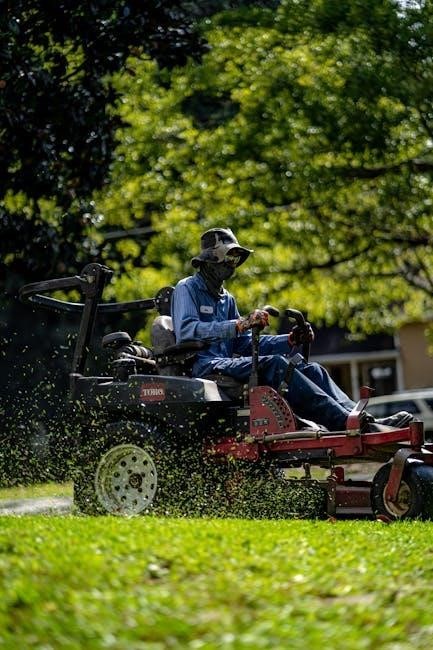
yardworks lawn mower owner’s manual
Welcome to the Yardworks Lawn Mower owner’s manual. This guide provides essential information for safe and efficient operation of your 19-inch cordless mower, ensuring optimal performance and longevity.
Product Overview
The Yardworks 622019-1 is a 19-inch cordless lawn mower powered by two 20V lithium-ion batteries, offering a combined 40V of power. Designed for efficiency and convenience, it features a sleek, lightweight design with a durable cutting deck. The mower includes two 4.0Ah batteries, providing extended runtime for medium-sized lawns. With its cordless operation, this mower eliminates the hassle of tangled cords while delivering consistent cutting performance. Ideal for homeowners seeking eco-friendly, low-maintenance mowing solutions, the Yardworks Lawn Mower combines innovative technology with user-friendly design to ensure a superior mowing experience. This model is part of Yardworks’ commitment to providing high-quality, reliable outdoor power equipment for yard care needs.
Key Features of the Yardworks Lawn Mower
The Yardworks Lawn Mower is a high-performance, cordless mowing solution designed for convenience and efficiency. It features a powerful 40V lithium-ion battery system, combining two 20V batteries for extended runtime. The 19-inch cutting deck ensures precise and even cutting, while the adjustable height settings allow for customized mowing to suit various grass types. The mower is lightweight and maneuverable, making it ideal for medium-sized lawns. Additional features include a mulching capability, eco-friendly operation, and low maintenance requirements. With its advanced battery technology and user-friendly design, this mower provides a reliable and efficient mowing experience, making it a practical choice for homeowners seeking a modern, eco-conscious lawn care solution.
Components and Accessories Included
Your Yardworks Lawn Mower package includes the main mower unit, two 20V 4.0Ah lithium-ion batteries, a charger, and a mulching kit. Additional components feature adjustable handlebars for comfort, a collection bag for grass clippings, and a protective cover for storage. The mower also comes with a detailed owner’s manual, ensuring proper assembly and operation. Optional accessories, such as replacement blades and additional batteries, can be purchased separately to enhance functionality. These components and accessories are designed to provide a comprehensive mowing experience, supporting both efficiency and convenience for maintaining your lawn effectively.
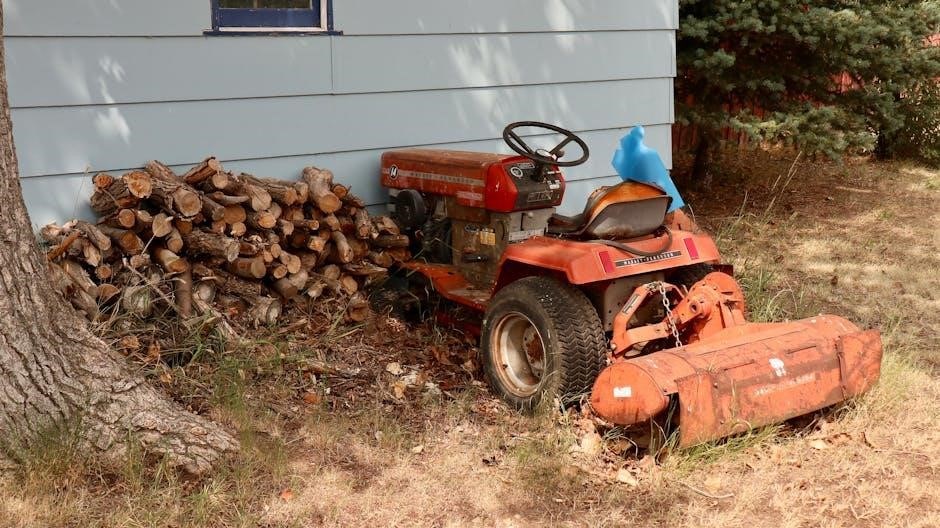
Model Identification and Serial Number Location
The model number and serial number for your Yardworks Lawn Mower can be found on a label located on the rear of the mower deck or on the side of the handlebar. These identifiers are essential for registering your product, ordering replacement parts, and accessing customer support. The model number typically starts with a combination of letters and numbers, such as “622019-1,” while the serial number is a unique sequence assigned to your specific unit. Refer to your owner’s manual for detailed instructions on locating these identifiers. Ensure to record these numbers for future reference, as they are required for warranty claims or repair services.

Safety Guidelines
Always follow safety guidelines to ensure safe operation of your Yardworks Lawn Mower. Wear protective gear, avoid hazards, and keep bystanders away. Ensure the mower is on a flat surface when not in use.
General Safety Precautions
Always read and understand the owner’s manual before using the Yardworks Lawn Mower. Ensure you are familiar with all controls and functions. Wear appropriate clothing and protective gear to avoid accidents. Keep loose clothing and long hair tied back. Ensure the mowing area is clear of obstacles, pets, and bystanders. Never operate the mower on uneven or slippery surfaces. Avoid mowing in extreme weather conditions or when under the influence of alcohol or drugs. Keep children and unauthorized individuals away from the mower. Always maintain a firm grip on the handle and operate the mower at a steady, controlled pace. Follow all safety guidelines to minimize risks and ensure safe operation.
Protective Equipment Recommendations
Always wear appropriate protective equipment when operating the Yardworks Lawn Mower to ensure personal safety. Wear sturdy, closed-toe shoes or boots to protect your feet from injury. Use gardening gloves to maintain a firm grip and prevent blisters. Safety glasses or goggles are essential to protect your eyes from debris. A hat or visor can shield your face and head from the sun and falling objects. Consider wearing long pants to protect your legs from grass clippings and potential debris. Avoid loose jewelry that could get caught in moving parts. Proper protective gear minimizes risks and ensures a safer mowing experience. Always prioritize safety when using the mower.
Safe Operating Practices
Always operate the Yardworks Lawn Mower with caution and attention to your surroundings. Clear the area of obstacles, toys, and debris before mowing to prevent accidents. Ensure children and pets are kept at a safe distance. Never mow in wet conditions, as this can cause slipping or electrical hazards. Maintain a steady, deliberate walking pace and avoid sudden turns or stops. When mowing slopes, always go up and down, never side to side. Keep hands and feet away from moving parts. Never reach under the mower while it is in operation. Keep the mower deck closed except when performing maintenance. Stay alert and avoid distractions like using a phone while mowing.
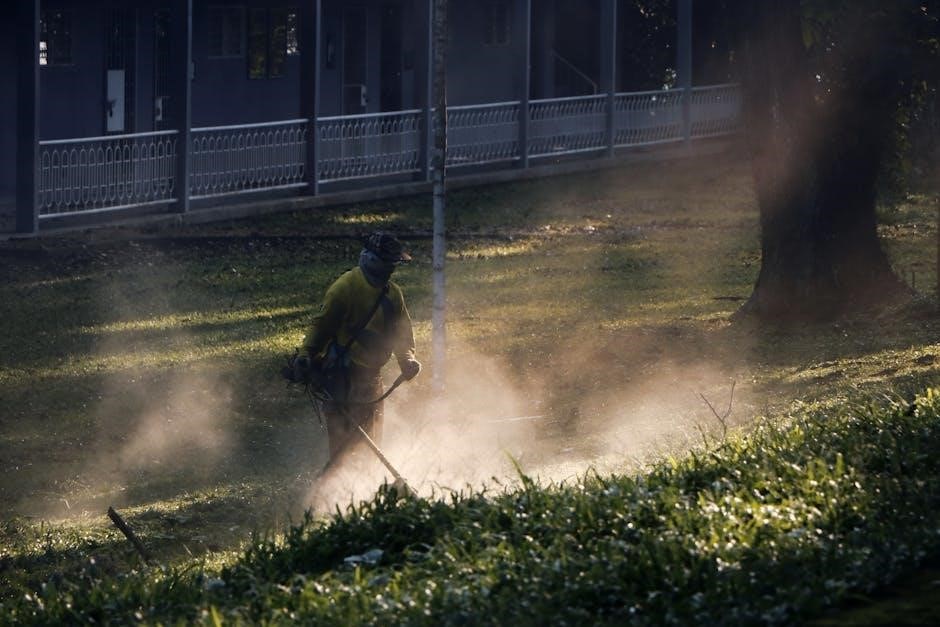
Assembly and Setup
Unpack and inspect the mower for damage. Attach handles securely and ensure all parts are included. Refer to the manual for specific assembly steps and safety guidelines.
Unpacking and Inventory of Parts
Begin by carefully unpacking the Yardworks lawn mower from its box. Inspect the unit for any visible damage during shipping. Locate and organize all included components, such as the mower deck, handlebars, wheels, battery, charger, and instruction manual. Cross-reference the parts list in the manual to ensure no items are missing. Take note of any pre-assembled sections to avoid confusion. Store small hardware like screws and bolts in a safe place to prevent loss. Double-check for accessories like a mulch bag or additional blades, if applicable. Familiarize yourself with each part’s purpose to streamline the assembly process. Verify that all safety features, such as emergency stop buttons, are intact and functional.
Step-by-Step Assembly Instructions
Begin by attaching the handlebars to the mower base using the provided bolts. Align the holes carefully and tighten securely. Next, install the wheels by sliding them onto the axles and securing with the retaining clips. Attach the mower deck to the main unit by aligning the mounting brackets and tightening the screws. Ensure all connections are snug to prevent vibration. Install the battery by sliding it into the compartment and securing the latch. Connect the electrical connectors as shown in the manual. Double-check all bolts and screws for tightness. Finally, test the safety features, such as the emergency stop, to ensure proper function before first use. Refer to the manual for specific torque values and assembly diagrams.
Charging the Batteries
To charge the battery, locate the charging port on the mower and connect the provided charger. Ensure the charger is plugged into a 120V electrical outlet. The charging indicator will illuminate, showing the current charge status. Allow the battery to charge for the recommended 8-12 hours for a full cycle. Avoid overcharging, as it may reduce battery life. Do not charge the battery in extreme temperatures or near flammable materials. Always use the original charger to prevent damage. If the battery does not charge, check for loose connections or damage to the charging cable. Store the battery in a cool, dry place when not in use. Refer to the manual for specific charging times and guidelines; Always follow safety precautions to prevent accidents. Clean the terminals regularly for optimal performance.
Initial Setup and Calibration
Before first use, ensure all components are properly assembled and tightened. Refer to the assembly instructions for guidance. Calibrate the mower by adjusting the blade and wheel alignment according to the manual. Test the mower on a flat surface to ensure even cutting and proper mobility. Check the blade height adjustment to confirm it operates smoothly. Verify that all safety features, such as the emergency stop, are functioning correctly. Perform a test run without cutting to ensure the mower moves effortlessly. Adjust the handle height for comfort and ergonomic operation. Familiarize yourself with the controls and settings before mowing. Ensure the mower is balanced and stable for optimal performance. Refer to the manual for specific calibration steps and adjustments. Always ensure the mower is properly calibrated to maintain cutting efficiency and safety.

Operating Instructions
Ensure safety by following startup procedures, adjusting settings, and monitoring operation. Always maintain control and visibility while mowing. Refer to specific guides for detailed operating steps.
Starting and Stopping the Lawn Mower
Before starting, ensure the area is clear of obstacles and wear protective gear. Press and hold the power button until the mower activates. For cordless models, ensure the battery is fully charged. While operating, maintain firm control and keep the mower moving steadily. To stop, release the power button and allow the blade to stop completely before moving the mower. For restart, repeat the startup process. Always refer to the manual for model-specific startup sequences. Regularly check battery levels and recharge as needed. Proper starting and stopping ensures safe operation and prolongs equipment life. Follow these steps carefully for optimal performance.
Adjusting Cutting Height
To adjust the cutting height, locate the height adjustment lever or knob on the mower deck. Pull or turn the lever to select one of the preset height positions, typically ranging from 1.5 to 4 inches. For precise control, some models feature a dial or bolt system requiring a wrench to tighten or loosen. Always ensure the mower is on level ground before adjusting. After setting the desired height, check the blade alignment to maintain even cutting performance. For optimal results, adjust the height based on grass type and desired lawn appearance. Refer to your model-specific manual for exact adjustment procedures, as mechanisms may vary. Proper height adjustment ensures a clean, professional finish and promotes healthy grass growth. Regularly inspect and adjust as needed to maintain consistent cutting performance. Always wear protective gear when making adjustments. By following these steps, you can achieve the perfect cut every time.
Using the Mower in Different Terrain Conditions
The Yardworks Lawn Mower is designed to handle various terrain conditions, but proper techniques are essential for optimal performance. On flat surfaces, maintain a steady pace to ensure even cutting. For slopes, always mow across the incline to avoid tipping and loss of control. When navigating uneven ground, reduce your speed and raise the cutting height slightly to prevent scalping the lawn. In wet or damp conditions, avoid mowing to prevent slipping and damaging the grass. For dense or tall grass, make multiple passes at a higher cutting height to avoid overloading the mower. Always check for debris before mowing rough terrain. Adjusting your technique based on terrain ensures safety and efficient mowing. Keep the mower blade at the recommended height for your grass type to maintain healthy growth. By adapting to different terrains, you can achieve consistent results while protecting your lawn and the mower. Regularly clean the mower deck after use in dense or wet conditions to prevent clogging. Follow these guidelines to maximize performance and longevity of your Yardworks Lawn Mower.
Handling and Steering Techniques
Proper handling and steering are crucial for safe and effective operation of the Yardworks Lawn Mower. Always maintain a firm grip on the handlebars, keeping your posture upright and balanced. When moving forward, apply gentle to moderate pressure to the handlebars to guide the mower in your desired direction. For tight turns, reduce your speed and pivot gradually to avoid loss of control; On slopes, make wider turns to maintain stability and prevent tipping. Use the mower’s intuitive controls to adjust direction smoothly, especially when navigating obstacles or changing mowing patterns. Practice in an open area to familiarize yourself with the mower’s responsiveness. By mastering these techniques, you can maneuver confidently and efficiently, ensuring precise cutting and optimal performance in various yard conditions.
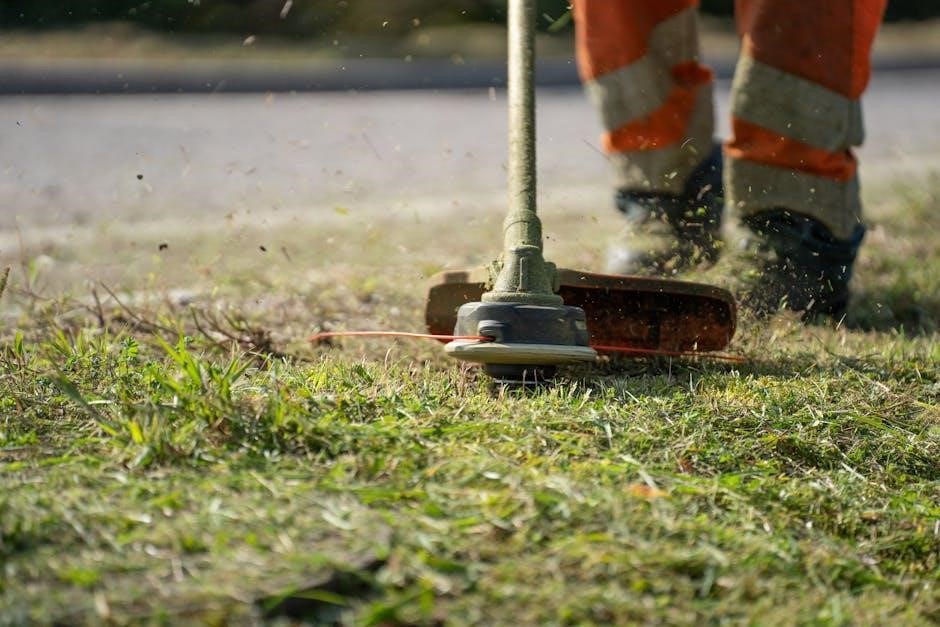
Maintenance and Care
Regularly clean the mower, lubricate moving parts, and sharpen or replace the blade as needed. Store the mower in a dry, protected area during off-season.
Daily Maintenance Checks
Perform daily inspections to ensure optimal performance and safety. Check the blade for sharpness and damage, clear debris from the mower deck, and verify proper tire inflation. Inspect the battery terminals for corrosion and ensure they are securely connected. Look for worn or loose belts and tighten any loose fasteners. Check the oil level if applicable and ensure all safety features, such as the emergency stop, are functioning correctly. Remove any accumulated grass clippings or dirt from the underside of the mower. Regularly clean the air filter to maintain proper airflow. Refer to the manual for specific procedures and recommendations tailored to your Yardworks model.
Cleaning the Lawn Mower
Clean your Yardworks lawn mower regularly to maintain performance and longevity; Turn off and unplug the mower before cleaning. Remove grass clippings and debris from the mower deck using a brush or soft cloth. Hose down the deck if necessary, then dry thoroughly to prevent rust. Clean the blade carefully, as it may be sharp. Wipe the exterior with a damp cloth, avoiding harsh chemicals that could damage the finish. Check and clean the air vents to ensure proper cooling. Remove dirt from the wheels and undercarriage. Regularly clean the discharge chute and bag, if equipped. Keep the mower dry and store it in a clean, dry area to prevent corrosion and damage.
Sharpening and Replacing the Blade
A sharp blade ensures clean cuts and efficient mowing. To sharpen the blade, disconnect the battery or spark plug for safety. Remove the blade and inspect for wear or damage. Use a file or grinder to sharpen the cutting edge, maintaining the original angle. Avoid overheating, as it can weaken the blade. If the blade is severely damaged or worn, replace it. Use only genuine Yardworks replacement blades for compatibility and safety. To replace, loosen the mounting bolt with a wrench, remove the old blade, and install the new one. Tighten securely in the correct direction. Always handle the blade with care due to its sharpness. Regular sharpening or replacement ensures optimal performance and prolongs mower lifespan.
Battery Maintenance and Storage
Proper battery care ensures optimal performance and extends lifespan. Store the battery in a cool, dry place, away from direct sunlight and flammable materials. Avoid extreme temperatures, as they can drain or damage the battery. Charge the battery fully before storage, especially during the off-season. Clean terminals with a wire brush to prevent corrosion. If you notice reduced runtime or power, recharge the battery. Never overcharge, as it can degrade the battery. Always use the recommended Yardworks charger to maintain compatibility and safety. Check the battery voltage periodically and ensure it is securely fastened during mowing to prevent movement. Proper storage and maintenance will ensure reliable operation and longevity of your lawn mower’s battery system.

Troubleshooting Common Issues
This section helps diagnose and resolve issues like battery drain, uneven cutting, or mobility problems. Follow step-by-step guides to identify and fix common faults effectively.
Diagnosing Battery-Related Problems
Identify battery issues by checking if the mower fails to start or operates with reduced power. Ensure the battery is fully charged and properly connected. Check the charge indicator for faults. Inspect cables and connections for damage or corrosion. Verify the charger is functioning correctly by testing it with another compatible battery. If issues persist, measure the battery voltage using a multimeter to detect drainage or internal damage. Consult the user manual for specific voltage thresholds. If the battery is under warranty, contact customer support for replacement. Always follow safety guidelines when handling batteries to avoid accidents.
- Charge the battery fully before testing.
- Inspect for loose or damaged connections.
- Use a multimeter to check voltage levels.
Addressing Cutting Performance Issues
If the mower isn’t cutting evenly or leaving grass uncut, check the blade for dullness or damage. A dull blade can be sharpened, but a damaged one must be replaced. Ensure the cutting height is set appropriately for your lawn type. Blocked discharge openings or a full grass bag can also reduce performance. Clean the mower deck regularly to maintain airflow and cutting efficiency. Check tire pressure, as uneven pressure may affect cutting consistency. If the issue persists, inspect the drive belt or cable for wear or misalignment. Proper blade engagement and correct mowing patterns can also impact performance. Always refer to the manual for specific adjustments and maintenance tips;
- Sharpen or replace the blade as needed.
- Adjust cutting height for optimal results.
- Clear debris from the mower deck and discharge chute.
Resolving Mobility and Steering Problems
If the mower is difficult to maneuver or the wheels are not turning properly, inspect for debris blocking the wheels or axles. Ensure tire pressure matches the recommended levels, as underinflated tires can hinder movement. Check the drive system for loose or damaged belts, and adjust or replace them if necessary. Lubricate pivot points and axles to maintain smooth operation. If the mower pulls to one side, adjust the steering mechanism or check for uneven tire wear. Test the mower on a flat surface after making adjustments to ensure proper mobility. Regular maintenance can prevent these issues and keep the mower moving efficiently.
- Clear debris from wheels and axles.
- Check and adjust tire pressure.
- Inspect and maintain the drive system.
Fixing Electrical and Control System Malfunctions
If the lawn mower experiences electrical or control system issues, start by checking the battery and connections. Ensure the battery is fully charged and terminals are clean and secure. If the mower does not start, verify the circuit breaker or fuse has not tripped or blown. For control-related problems, such as unresponsive buttons or levers, reset the system by turning the mower off and on. Inspect sensors and wiring for damage or obstruction. If issues persist, consult the wiring diagram or contact a professional. Avoid attempting repairs that could cause further damage or safety hazards. Always refer to the manual for specific troubleshooting steps.
- Check battery charge and connections.
- Inspect circuit breakers or fuses.
- Reset the control system.
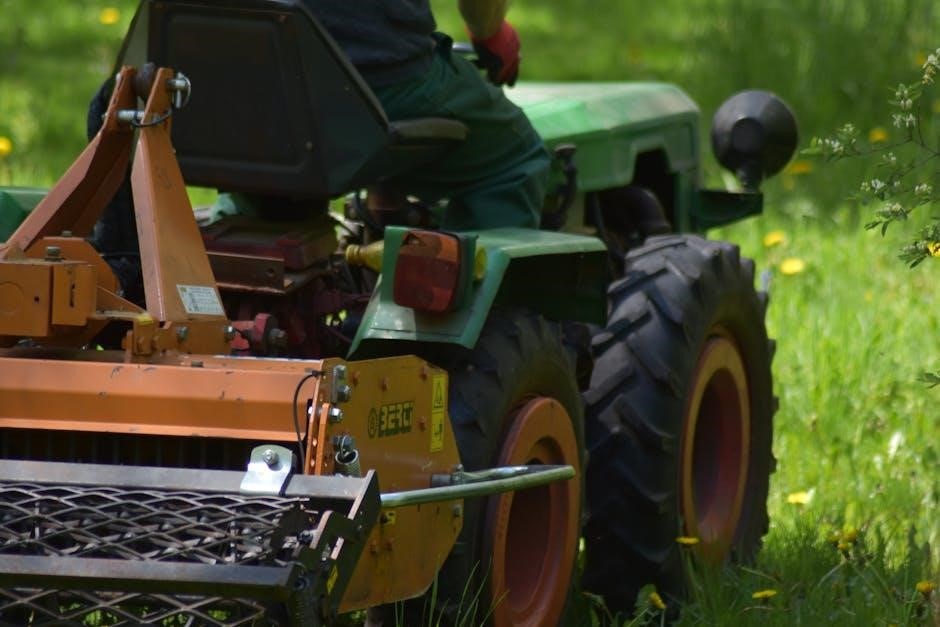
Parts and Accessories
Explore genuine Yardworks parts and accessories designed to enhance performance and longevity. Find replacement blades, batteries, and optional features tailored for your lawn mower needs.
Identifying Replacement Parts
To identify replacement parts for your Yardworks lawn mower, refer to the detailed diagrams and part numbers listed in this manual. Each component, such as blades, wheels, or handles, is labeled with a specific identification code. Match these codes to the parts catalog or manufacturer’s website for accurate ordering. Ensure compatibility by verifying the model number and serial number before purchasing. Common replacement parts include cutting blades, mulching kits, and battery packs. Always consult the parts list or contact customer support for assistance. Proper identification ensures correct fitment and optimal performance, preventing potential damage from incompatible parts. This step is crucial for maintaining your mower’s efficiency and safety standards.
Purchasing Genuine Yardworks Accessories
To ensure optimal performance and compatibility, always purchase genuine Yardworks accessories from authorized dealers or the official Yardworks website. Genuine parts are designed specifically for your lawn mower model, guaranteeing a perfect fit and reliable operation. Look for the Yardworks logo and part number verification to avoid counterfeit products. Accessories like blades, bags, and batteries are readily available and backed by a manufacturer warranty. When ordering, use your mower’s model and serial number to select the correct items. This ensures safety, maintains your mower’s efficiency, and prevents voiding the warranty. Genuine accessories are engineered to meet Yardworks’ quality standards, providing long-lasting durability and consistent results.
Installing Optional Accessories
Optional accessories, such as mulch kits, striping attachments, or cargo bags, can enhance your lawn mowing experience. Before installation, ensure the accessory is compatible with your Yardworks lawn mower model. Refer to the accessory’s instructions for specific mounting locations and hardware requirements. Turn off and disconnect the mower from the power source for safety. Follow the step-by-step guide provided with the accessory, ensuring all bolts and clips are securely tightened. After installation, test the accessory on a small area to confirm proper function. If unsure, consult the owner’s manual or contact Yardworks support for assistance. Proper installation ensures safety and optimal performance of your lawn mower and accessories.
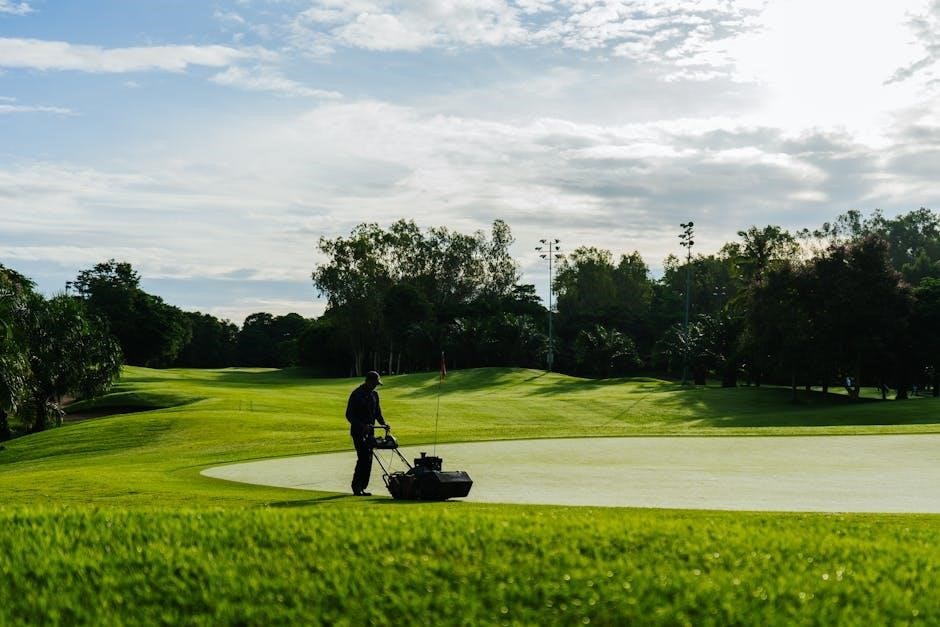
Warranty and Support
Your Yardworks lawn mower is backed by a comprehensive warranty covering parts and labor for a specified period. Contact customer support for inquiries or claims. Registration required.
Understanding the Warranty Coverage
Your Yardworks lawn mower is covered by a limited warranty that protects against manufacturing defects. The warranty period varies by component, typically ranging from 2 to 5 years. It covers defects in materials and workmanship under normal use. Repairs or replacements are provided at the manufacturer’s discretion. Coverage excludes damage caused by misuse, accidents, or unauthorized modifications. For details, refer to the warranty document provided with your purchase. Ensure to register your product to validate the warranty. Contact Yardworks customer support for any warranty-related inquiries or claims. Proper documentation, such as proof of purchase, may be required to process claims. Warranty terms may vary by region, so review your specific agreement carefully.
Contacting Customer Support
To contact Yardworks customer support, visit their official website and navigate to the “Support” section. You can reach them via phone, email, or live chat. Phone support is available Monday through Friday, 8:00 AM to 5:00 PM EST. For email inquiries, expect a response within 24-48 hours. Live chat is available during business hours for immediate assistance. Additionally, the website offers a comprehensive FAQ section and downloadable resources. When contacting support, have your model number, serial number, and purchase details ready. For warranty or repair requests, include a detailed description of the issue. You can also mail correspondence to the address provided in the manual. Always verify contact information on the official Yardworks website for accuracy.
Registering Your Product
Register your Yardworks lawn mower to ensure warranty validation and access to exclusive support services. Visit the official Yardworks website and navigate to the “Product Registration” page. Enter your personal details, product information, and purchase date. Locate the model and serial number on the product’s data plate or in the manual. Submit the form and keep the confirmation email for your records. Registration helps Yardworks provide tailored assistance and notify you about updates or recalls. It also verifies your ownership for warranty claims. Ensure all information is accurate to avoid delays. For assistance, refer to the website’s support section or contact customer service using the details provided in the manual.

Environmental Considerations
Adopt eco-friendly practices to minimize your lawn mower’s environmental impact. Always dispose of batteries responsibly and recycle old mower parts. Use energy-efficient settings and maintain sharp blades to reduce energy consumption and emissions. Regularly clean up grass clippings to prevent waste and promote healthy lawn growth. Properly store fuel and chemicals to avoid leaks and contamination. Follow local recycling guidelines for yard waste and old equipment. By taking these steps, you contribute to a more sustainable and environmentally conscious mowing routine.
Proper Disposal of Batteries
Properly dispose of your Yardworks lawn mower batteries to protect the environment. Check local regulations for battery disposal guidelines. Remove batteries before recycling or disposal. Recycle lithium-ion or lead-acid batteries at designated facilities. Do not dispose of batteries in regular trash, as they can leak harmful chemicals. Wrap batteries securely to prevent short circuits. Participate in community collection events for hazardous waste. Ensure batteries are fully discharged before disposal. Avoid crushing or puncturing batteries. Contact local authorities or recycling centers for specific instructions. Responsible battery disposal helps safeguard the environment and conserve resources for future generations.
Eco-Friendly Mowing Practices
Adopt eco-friendly mowing practices to reduce your environmental impact. Use your Yardworks lawn mower during cooler parts of the day to minimize grass stress and energy consumption. Maintain your blade at the recommended sharpness to ensure efficient cutting and reduce energy use. Leave grass clippings on the lawn to act as a natural fertilizer, reducing the need for chemical additives. Avoid over-mowing, as taller grass promotes healthier root systems and requires less water. Use the mulching feature to return nutrients to the soil. Follow proper battery care to maximize efficiency and lifespan. By embracing these practices, you contribute to a greener, more sustainable lawn care routine.
Recycling Guidelines for Yardworks Products
Yardworks is committed to environmental sustainability. To recycle your lawn mower responsibly, first disconnect the battery and dispose of it at an approved e-waste or battery recycling center. Remove any plastic or metal components and separate them for recycling. Check local recycling facilities to see if they accept lawn mower parts. Many communities offer special collection events for large appliances. Additionally, Yardworks partners with recycling programs to ensure proper handling of their products. Visit the Yardworks website for a list of authorized recycling centers near you. By recycling, you help conserve resources and reduce landfill waste, supporting a greener future.